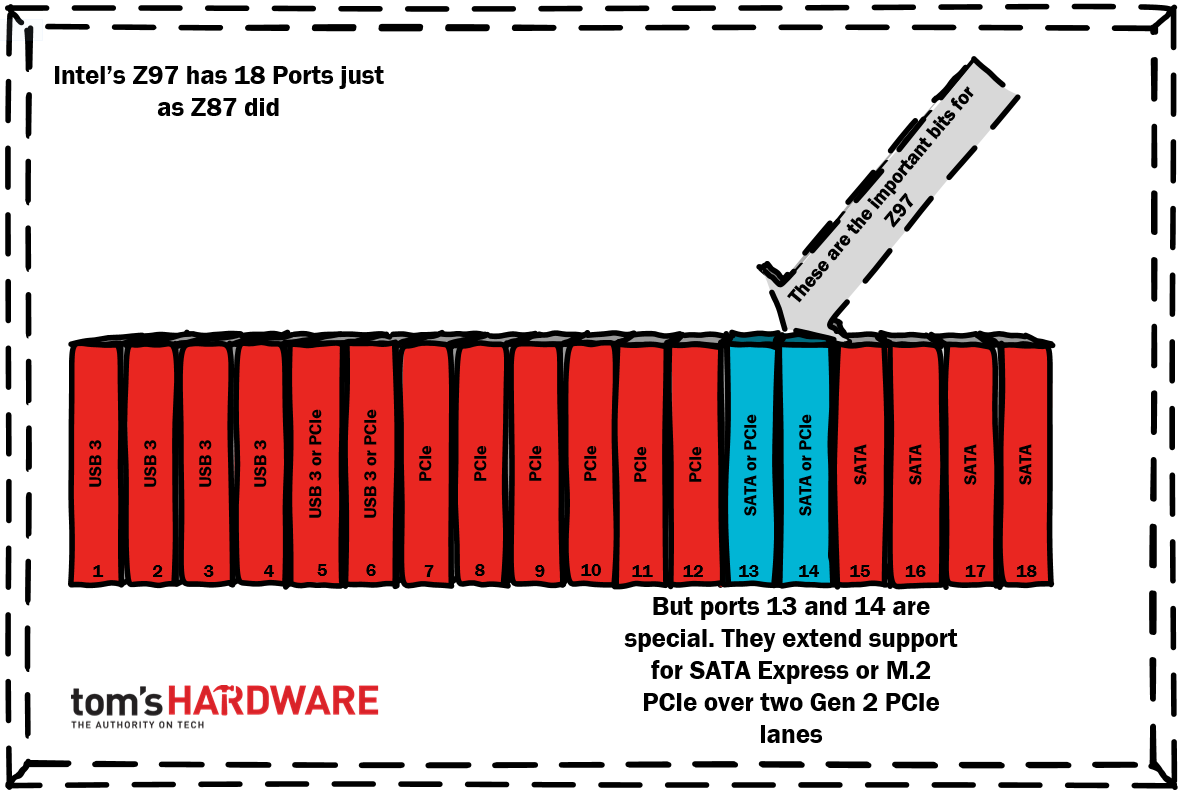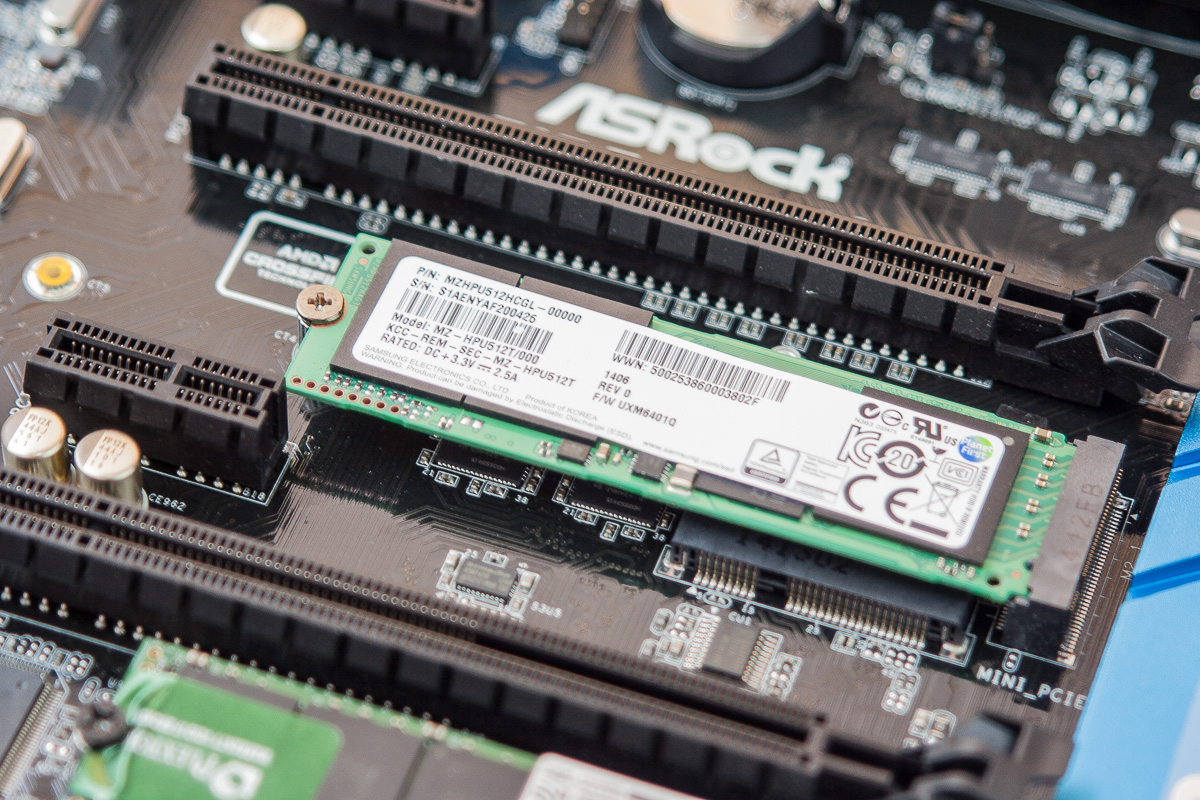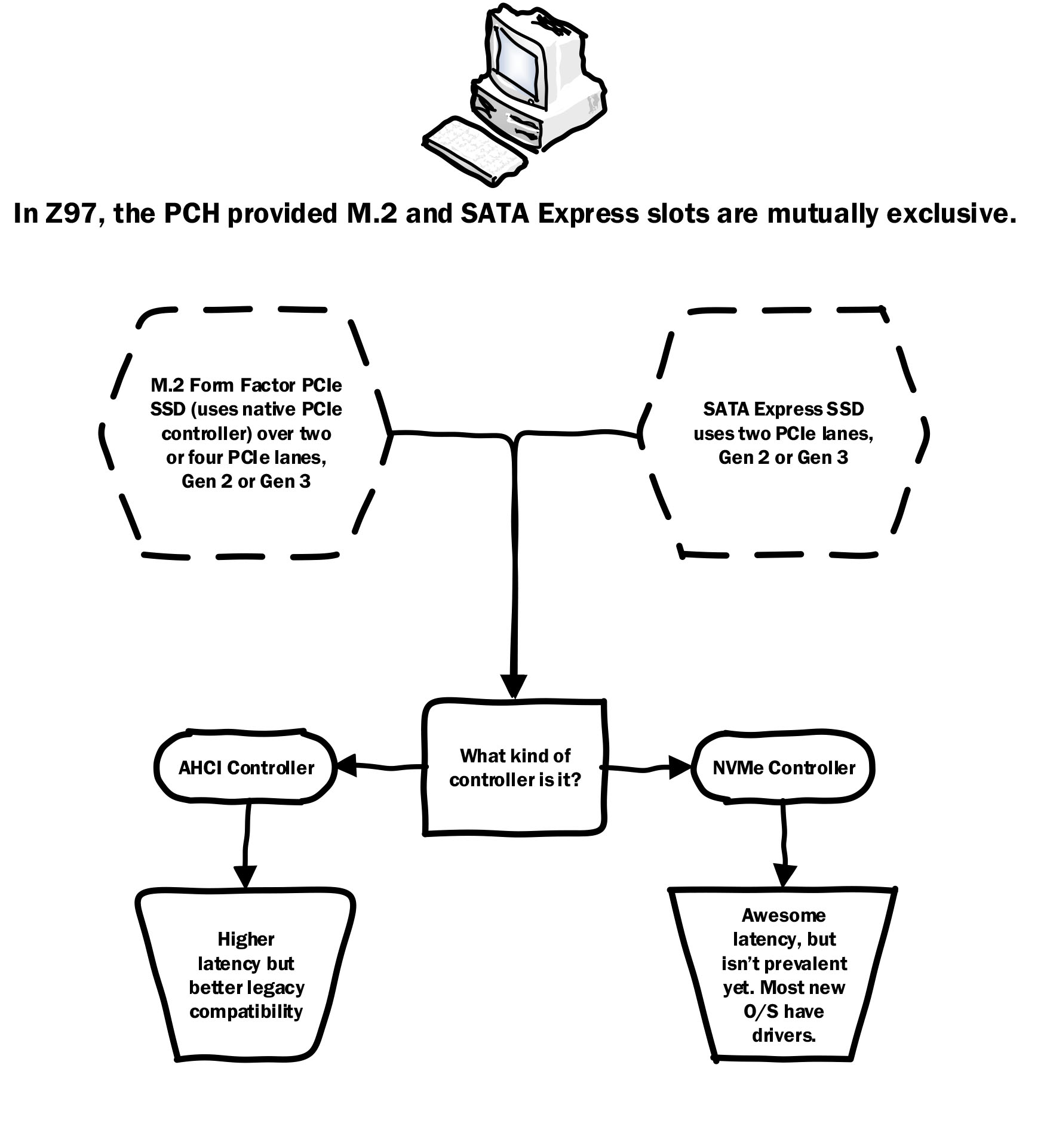A 1400 MB/s SSD: ASRock's Z97 Extreme6 And Samsung's XP941
Z97 ushers in new and exciting ways to attach and use storage devices. With support for M.2 PCIe and SATA Express, two sides of the same SSD coin, Z97 improves on Z87. But not everywhere. AsRock add to Z97 with some new tricks, and so we take a look.
M.2 And SATA Express, Discussed
M.2 PCIe
Intel ratchets up the utility and flexibility of Z97 in a small but profound way. This is achieved by making the chipset’s port 13 and 14 far more flexible than they were in the past. Previously, those two ports facilitated two of the PCH's six SATA interfaces. Now they're flexible, accommodating two big pieces of storage infrastructure: SATA Express and M.2 PCIe.
M.2 PCIe isn’t anything new. As far back as September of last year we were covering that in SanDisk A110 PCIe SSD: Armed With The New M.2 Edge Connector. More recently, we posted Plextor M6e 256 GB PCI Express SSD Review: M.2 For Your Desktop, testing the M.2 PCIe-based SSD on a half-length, half-height add-in board. We were told Plextor was also planning a version without the adapter, which suggested that there'd be motherboards with the corresponding two-lane slots. That day should be today. But as boards equipped with M.2 PCIe slots start selling, SSDs able to drop into them are few and far between.
It's actually pretty easy to mix up M.2 for PCIe and SATA. We're facing the same sort of confusion experienced when mSATA surfaced for mini-PCIe slots. Except this time, it's ever harder to distinguish between M.2 storage with SATA controllers and M.2 PCIe SSDs. So let's just forget about the SATA-based drives and focus on storage natively designed to drop onto the PCI Express bus through the M.2 form factor.
This form factor is flexible in that it can be molded into a wide range of single- or double-sided PCBs. An M.2 device is 22 mm wide, easily fitting a processor and NAND flash packages. Build a longer PCB and you get more space to add flash. Considering Samsung can cram its 1 TB 840 EVO mSATA into roughly the same space as a M.2 2260 (60 mm-long) form factor, something like a M.2 22110 (110 mm-long) gives you a ton of space to work with. And as manufacturing advances, increasing density, it's hard to imagine a day when M.2 will limit the upper bound of capacity.
| M.2 Real Estate (in mm) | 42 mm (M.2 2242) | 60 mm (M.2 2260) | 80 mm (M.2 2280) | 110 mm (M.2 22110) |
|---|---|---|---|---|
| Single-Sided | 924 mm2 | 1320 mm2 | 1760 mm2 | 2420 mm2 |
| Double-Sided | 1848 mm2 | 2640 mm2 | 3520 mm2 | 4840 mm2 |
Most M.2 PCIe SSDs will utilize two PCI Express lanes (in the case of Z97 Express, of course that means second-gen transfer rates). But Samsung's XP941 is unique in that it communicates over four. That makes it the most ideal candidate for testing ASRock's Z97 Extreme6 and its four-lane PCI Express 30 Ultra M.2 socket.
SATA Express
SATA Express replaces SATA 6Gb/s. The Serial ATA International Organization realized that doubling SATA's transfer rate again wasn't going to be practical. As Paul Wassenberg of Marvell fame told me last year at Flash Memory Summit 2013, SATA Express makes a lot more sense.
As the working group scaled up SSDs from one to eight PCIe lanes in testing, power consumption went through the roof as lanes were attached. But with just two lanes at third-gen transfer rates, power didn’t increase much compared to a SATA 6Gb/s-connected equivalent drive, even as performance was vastly superior. We know from the challenges presented by 12 Gb/s SAS that a cost-effective implementation would be difficult to achieve for SATA. Meanwhile, SATA Express wouldn't be as problematic. Given its PCI Express roots, however, cabling was the challenge to address.
Get Tom's Hardware's best news and in-depth reviews, straight to your inbox.
Unlike M.2 PCIe SSDs, which can span up to four lanes, SATA Express uses just two. But whereas a M.2 PCIe-based drive is basically stuck to the motherboard, SATA Express employs cables to make more remote connections, just like SATA. This poses a few practical issues. An external PCIe-based SSD needs a signal from the clock generator. Carrying that signal over distance requires shielding and a beefier (more expensive) cable. So, to combat a prohibitively pricey implementation, the signal can be provided by the solid-state device itself.
Gain a Port, Lose a Port
Based on Intel's implementation of SATA Express in Z97, if you utilize the new technology, you lose access to two of the storage controller's SATA 6Gb/s ports and the M.2 interface. If you instead choose to go with M.2 (the devices are more plentiful, after all), you can't use SATA Express.
To help add a bit of clarity, I created the flow chart above to clarify M.2 PCIe and SATA Express, along with the AHCI and NVMe interface specifications.
On Z97, the PCH-provided M.2 and SATA Express ports are mutually exclusive. You cannot use both simultaneously. Asus is adding third-party SATA Express controllers to some boards, so obviously those are able to operate independently. And then there's ASRock's solution: borrowing four lanes from the CPU's PCI Express controller to create the Ultra M.2 slot. Let's look at that in more depth...
Current page: M.2 And SATA Express, Discussed
Prev Page High-Performance Storage On ASRock's Z97 Extreme6 Next Page Z97 Express: The Same Old Bandwidth Limitations-
aminebouhafs Once an SSD in plugged into the Ultra M.2 slot, the bandwidth between central processing unit and graphics processing unit is cut-down by half. Therefore, while the end-user gets additional SSD performance, the end-user may lose some GPU performance because of insufficient bandwidth between it and the CPU.Reply -
JoeArchitect Very interesting article and a great read. Thanks, Chris - I hope to see more like this soon!Reply -
Eggz This makes me excited for X99! With 40 (or more) lanes, of PCI-e (probably more), there will be no need to compromise. We have to remember that the Z97 Chipset is a consumer-grade product, so there almost has to be tradoffs in order to justify stepping up to a high-end platform.Reply
That said, I feel like X99, NVMe, and and M.2 products will coincide nicely with their respective releases dates. Another interesting piece to the puzzle will be DDR4. Will the new storage technology and next-generation CPUs utilize it's speed, or like DD3, will it take several generations for other technologies to catch up to RAM speeds? This is quite an interesting time :) -
Amdlova Chris test the asrock z97 itx... and another thing... my last 3 motherboard from asrock and i want to say Asrock Rock's!Reply -
Damn_Rookie While storage isn't the most important area of computer hardware for me, I always enjoy reading Christopher's articles. Very well written, detail orientated, and above all else, interesting. Thanks!Reply -
hotwire_downunder ASRock has come along way, I used them a long time back with disappointing results, but I have started to use them again and have not been disappointed this time around.Reply
Way to turn things around ASRock! Cheap as chips and rock steady! -
alidan @aminebouhafs if i remember right, didn't toms show how much performance loss there is when you tape gpu cards to emulate having half or even a quarter of the bandwidth? if i remember right back than the difference was only about 12% from 16 lanes down to either 4 or 8Reply -
Eggz Reply13445787 said:@aminebouhafs if i remember right, didn't toms show how much performance loss there is when you tape gpu cards to emulate having half or even a quarter of the bandwidth? if i remember right back than the difference was only about 12% from 16 lanes down to either 4 or 8
PCI-e 3.0 x8 has enough bandwidth for any single card. The only downside to using PCI-e lanes on the SSD applies only to people who want to use multiple GPUs.
Still, though, this is just the mid-range platform anyway. People looking for lots of expansion end up buying the X chipsets rather than the Z chipsets because of the greater expandability. I feel like the complaint is really misplaced for Z chipsets, since they only have 16 PCI-e lanes to begin with. -
cryan ReplyOnce an SSD in plugged into the Ultra M.2 slot, the bandwidth between central processing unit and graphics processing unit is cut-down by half. Therefore, while the end-user gets additional SSD performance, the end-user may lose some GPU performance because of insufficient bandwidth between it and the CPU.
Well, it'll definitely negate some GPU configurations, same as any PCIe add-in over the CPU's lanes. With so few lanes to work with on Intel's mainstream platforms, butting heads is inevitable.
Regards,
Christopher Ryan


